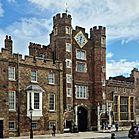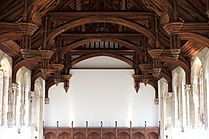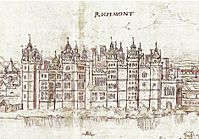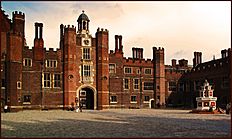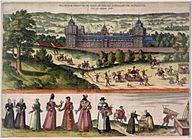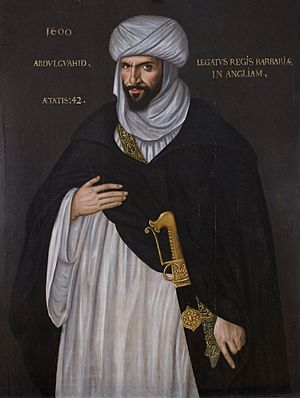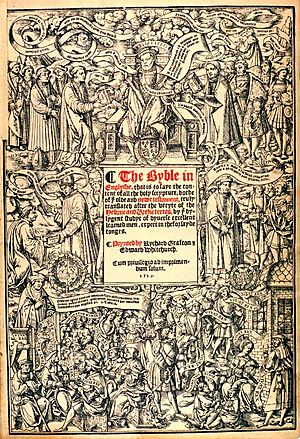Tudor London facts for kids
| 1485–1603 | |
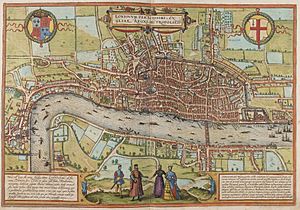
Map of London prior to 1561 by Georg Braun and Frans Hogenberg in "Civitates Orbis Terrarum"
|
|
| Preceded by | Norman and Medieval London |
|---|---|
| Followed by | Stuart London |
| Monarch | Henry VII, Henry VIII, Edward VI, Lady Jane Grey, Mary I, Elizabeth I |
The Tudor period in London began in 1485 when Henry VII became king. It ended in 1603 with the death of Elizabeth I. During these years, London grew a lot. Its population jumped from about 50,000 people in the late 1400s to around 200,000 by 1603. This made London over 13 times bigger than Norwich, the next largest city in England.
The city also spread out, going beyond its old medieval walls. By the end of the Tudor period, it reached as far west as St. Giles. In 1598, a historian named John Stow called London "the fairest, largest, richest and best inhabited city in the world."
Contents
London's Layout and Growth
The part of London inside the old medieval walls was known as the City of London. It had many timber-framed houses. Often, their upper floors stuck out over the street below. Two old London houses from this time that still exist are the King's House inside the Tower of London and Staple Inn.
London grew quickly outside its old city limits. The government tried to stop this spread of buildings many times. Laws in 1580, 1583, and 1593 said new houses could not be built on less than 4 acres of land. These laws applied to areas as far away as Chiswick or Tottenham. But these rules had an unexpected effect. Landlords inside the city walls started dividing their buildings into smaller and smaller parts. Landowners outside the walls built quickly and secretly, often not very well. By 1605, soon after the Tudor period, about 75,000 people lived inside the City of London. Another 115,000 lived in the surrounding areas called "liberties," like St. Martin's-le-Grand and Blackfriars.
The East End of London also grew during this time. This happened because farmers were forced off their land and moved to cities. Also, London's guilds (groups that controlled trades) had less power there. This allowed businesses to operate without strict rules. The historian John Stow remembered that Petticoat Lane used to be among fields with hedges when he was young. But it became "a continual building of garden houses and small cottages." Wapping also turned into a "continual street or filthy straight passage with alleys of small tenements." By the end of the period, Whitechapel changed from a rural area to a busy industrial hub. It had tanneries (for leather), slaughterhouses, breweries, and foundries (for metal).
Mapping London's Growth
The first maps of London were made during the Tudor period. One famous map was by George Hoefnagel and Frans Hogenberg. It was published in 1572 but showed the city as it looked around 1550. The Agas map, likely made by Ralph Agas, was created around 1561. John Norden made maps of the City and Westminster for his book Speculum Britanniae in 1593. In 1598, John Stow published his Survey of London. This book gave a detailed description of the city's places and history.
Royal Palaces and Grand Homes
The number of royal palaces in London grew a lot during this time. Most of these were built or expanded by Henry VIII. Some palaces that existed before the Tudor period were also made larger. The Palace of Westminster was badly damaged by fire in 1512. After that, it was no longer a home for the royal family. Instead, it was used for government offices and for the monarch to meet Parliament.
The Tower of London was used for royal processions to Westminster Abbey for coronations. It was also a place for imprisonment and executions. Famous prisoners included Anne Boleyn, Catherine Howard, and Lady Jane Grey.
Eltham Palace was where Henry VIII spent his childhood. He learned music and languages there. He made it bigger between 1519 and 1522. Shene Palace burned down in 1497. Henry VII rebuilt it as Richmond Palace, which had golden domes and tall spires. Both Henry VII and Elizabeth I died there. Greenwich Palace was also rebuilt by Henry VII. Henry VIII, Mary I, and Elizabeth I were all born there.
Hampton Court Palace was first built by Henry VIII's advisor, Thomas Wolsey. Henry took it over in 1529. He turned it into a huge pleasure palace with tennis courts, bowling alleys, and a jousting area. It had large kitchens and a Great Hall. His third wife, Jane Seymour, died there. His son, Edward VI, was born there. He also married his sixth wife, Catherine Parr, there.
Henry also took York Place from Wolsey. He made it much larger, calling it Whitehall Palace. It had a tiltyard (for jousting) and a tennis court. It also had a royal mews (stables) for horses and hunting falcons near Charing Cross. Henry VIII died at Whitehall Palace in 1547.
In 1531, Henry took over the St. James monastic leper hospital. He rebuilt it as St. James's Palace. He also had Nonsuch Palace built in 1538. In 1543, Henry gave Chelsea Manor House to his sixth wife, Catherine Parr. She lived there after his death in 1547. In the same year, he built the Great Standing in his hunting grounds at Epping Forest.
From 1515, Henry VIII had Bridewell Palace built outside the City walls. In 1553, Edward VI gave it to the City of London. It was turned into a workhouse, the first of its kind in Europe. Officers from Bridewell could go into pubs, cock-fighting pits, and gambling places. They would arrest homeless, unemployed, or disorderly people and take them to Bridewell.
Many other grand houses were built or owned by important people. Belsize House was built in Hampstead before 1550. The Archbishop of Canterbury finished the gatehouse to his Lambeth Palace in 1501. The Bishop of London rebuilt his main house, Fulham Palace, starting in 1510. In 1514, William Compton bought the manor of Tottenham and rebuilt Bruce Castle.
Along the Strand street, there were many mansions. These included Somerset House, the Savoy Palace, and Durham Place. Many of these were first owned by bishops or abbots. But in the 1530s and 1540s, they were taken over by wealthy noble families. Thomas More, a famous chancellor, built a mansion in Chelsea where he lived in the 1520s. Other notable houses included Eastbury Manor House (1556–1578), Osterley Park (around 1576), and Hatton House in Holborn (1577).
Other Important Buildings
Lincoln's Inn Hall was built between 1489 and 1492. The politician and lawyer Thomas More often visited it. Henry VII added the beautiful Henry VII Chapel to Westminster Abbey from 1503 to 1510. He and his wife, Elizabeth of York, are buried there. His grandchildren, Edward VI, Mary I, and Elizabeth I, were also later buried inside. The gatehouse to St. John Clerkenwell priory was finished in 1504 and still stands today. The Prospect of Whitby pub, then called the Devil's Tavern, was supposedly built in 1520 on Wapping Wall.
In 1561, lightning struck Old St Paul's Cathedral. The roof was fixed, but the tall 500-foot spire was never replaced. Middle Temple Hall was built around 1570. Elizabeth I often visited it.
Disasters often meant rebuilding work. Big fires happened in 1485, 1504, 1506, and 1538. In 1506, a huge storm blew tiles off houses and the weathervane off St. Paul's Cathedral. In 1544, 1552, 1560, and 1583, gunpowder stores exploded in London. These explosions often killed people and damaged buildings. In April 1580, the Dover Straits earthquake caused some damage to chimneys and walls.
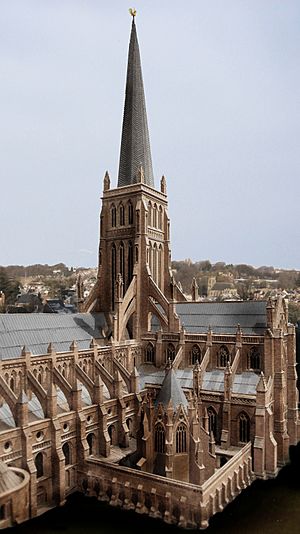
London's Growing Population
At the end of the 1400s, London's population was about 50,000. By 1603, this number grew to an estimated 200,000. This was more than 13 times the size of Norwich, the next largest city in England. Between 1523 and 1527, a national tax was collected. Londoners paid £16,675, which was more than the total amount from the next 29 cities in England combined.
Most Londoners married in their early or mid-twenties. Families living around Cheapside had about four children on average. But in the poorer area of Clerkenwell, the average was only two and a half children. It's thought that half of all children did not live past the age of 15.
The plague hit London very hard in 1563. Because of this, local officials started keeping records of deaths for the first time. These records were called the Bills of Mortality. In 1563, 20,372 people died in London that year. Of those, 17,404 died from the plague. Some years were much safer. In 1582, only 6,930 deaths were recorded, with 3,075 from the plague. But in 1603, the total was 40,040 deaths, and 32,257 of those were from the plague.
People from Other Places
People came to London not just from all over England and Wales, but also from other countries. In 1563, there were about 4,543 foreigners in London. By 1568, this number grew to 9,302. By 1583, it was 5,141. Almost 25% of foreigners lived in villages outside London. Inside the city, French hat makers stayed in Southwark. Silk weavers lived in Shoreditch and Spitalfields. Dutch printers were based in Clerkenwell.
Protestants came to London to escape religious persecution in Catholic countries like Spain, France, and Holland. In 1550, the chapel at St. Anthony's Hospital became a French church. The chapel at Austin Friars became a Dutch church. These churches were allowed to operate differently from the main Church in England.
This period also saw the first large movement of people from Ireland to London. Irish migrants often settled in Wapping and St. Giles-in-the-Fields. Most of them were Catholic, so Queen Elizabeth I, who was Protestant, did not welcome them. In 1593, she banned Irish migrants unless they owned a home, were domestic servants, lawyers, or university students. Even though Jews had been banned from England in the 13th century, a small community of 80-90 Portuguese Jews lived in London during Elizabeth I's reign.
The Tudor period also gives us London's first known portrait of a black person. This was the royal trumpeter John Blanke. He performed for Henry VII and Henry VIII. Other records mention a "blakemor" who arrived with Philip II of Spain when he came to London to marry Mary I. There was also an African needlemaker who worked on Cheapside.
In 1600, an ambassador from modern-day Morocco, named Abd el-Ouahed ben Messaoud, came to London. He wanted to form an alliance between the King of Barbary and Elizabeth I. He brought 17 other Muslim men with him. A portrait of him was painted during his visit.
In 1602, a judge said that there were 30,000 "idle persons and masterless men" (meaning homeless or unemployed people) living in London.
The River Thames
The Thames was London's main river. It was also the city's most important route for trade with Europe and the rest of the world. The river was wider and shallower than it is today. In 1564, it froze completely. Elizabeth I and her courtiers even held an archery practice on the ice.
During this period, there was only one bridge: London Bridge. It was often very crowded. So, using wherries (small ferry-boats) to cross the river or travel up and down it was a key way to get around London. It's estimated that 2,000 wherries were on the river.
Because the Thames was so important for trade, it was lined with small wharfs in London. These were especially common on the north bank between London Bridge and the Tower of London. Most of these small wharfs were used for a specific type of trade. For example, Beare Quay was for ships from Portugal. Gibson's Quay was for lead and tin. Somers Quay was for merchants from Flanders. In 1559, a rule listed the official wharfs along the river. It also said that all imported goods had to be declared at Custom House.
Around 1513, royal dockyards were set up at Woolwich and Deptford. These were built to create a national fleet of ships. The first ship built at Woolwich was the Henry Grace à Dieu. It was the largest ship in the world at that time.
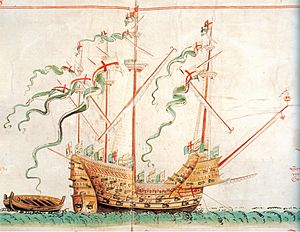
London Bridge's Unique Look
In the Tudor period, London Bridge looked very different from today. It had houses and shops up to four stories tall built on both sides. At the south end was a drawbridge. This allowed tall ships to pass and also helped defend the city. In 1579, the tower that held the drawbridge was replaced by Nonsuch House. This was a fancy mansion built in the Netherlands and then put together in London. South of Nonsuch House was the Great Stone Gate. Here, the heads of traitors, like Thomas More, were displayed on spikes.
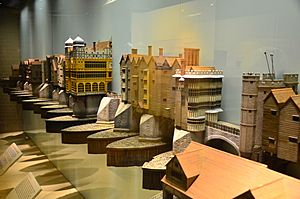
How London Was Governed
The monarch (king or queen) had much more direct power to pass laws than today. Most Tudor monarchs called Parliament to meet once a year. They often met at the Palace of Westminster. However, Elizabeth I only called Parliament ten times during her 45-year reign.
The City of London was governed by the Court of Aldermen. This was a group of officials, each representing a part of the City called a ward. Before 1550, there were 25 wards. Southwark was added in that year, making 26. Each year, the aldermen chose one of their group to be the Lord Mayor. The law-making part of the City leadership was the Common Council, which had over 200 members. The City's government was based in the Guildhall, where it still is today.
Religion in Tudor London
At the start of the Tudor period, London had 46 monasteries, nunneries, priories, abbeys, and friaries. These were religious communities. Examples included Greyfriars, Blackfriars, and Westminster Abbey. Many wealthy Londoners left money and land to these places in their wills. By 1530, about a third of all land within the city walls was owned by the Church. London also had individuals who lived alone with religious vows, like a hermit on Highgate Hill.
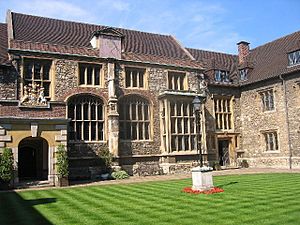
The English Reformation
To end his marriage to Catherine of Aragon, Henry VIII passed several laws in the 1530s. These laws broke the Church in England away from the Catholic Church in Rome. Henry became the Supreme Head of the Church in England. In April 1534, every male Londoner had to swear the Oath of Succession. This meant they agreed to accept the king's marriage annulment.
At the monastery of London Charterhouse, the Carthusian monks refused to accept Henry as head of the church. Four of them, including their leader John Houghton, were executed. The monastery was taken by the Crown and later given to noblemen.
Other monasteries were closed down in a less violent way. But their lands and buildings were still given or sold to aristocrats and politicians. For example, Lord Cobham got Blackfriars Priory. Covent Garden, which was farmland belonging to Westminster Abbey, was given to the Earl of Bedford. Henry also took some monastic sites for himself. He turned a hospital into St. James's Palace. He also took land from Westminster Abbey and turned it into Hyde Park. It's thought that the monastic lands Henry took were worth three times the land he already owned. By 1551, a visitor wrote that London was "disfigured by the ruins of a multitude of churches and monasteries."
In 1535, an official English Bible was published. In 1539, six copies of the Great Bible were placed in St. Paul's Cathedral. Anyone could go there to read them or listen to others read aloud. Churches were also changed physically. Jewels, rood lofts (screens), and statues of saints were removed. Sometimes officials took them down. But in other churches, like St. Margaret Pattens, groups wanting reform destroyed these objects. Under Edward VI, more Protestant changes were made. For example, chantry chapels (where prayers were said for the dead) were abolished. Images of saints and stained glass were also removed.
After 1550, no new churches were built in London for over 70 years. St. Giles-without-Cripplegate was finished in 1550. The next new church was built after the Tudor period, in 1623.
When the Catholic Mary I became queen in 1554, many Protestant changes were reversed. However, monastery lands were not given back to the Church. Some Londoners quickly put saints' images back in their churches. But others strongly opposed bringing back Catholic traditions. The priest of St. Ethelburga's, John Day, was punished twice for speaking badly about the new queen. In 1554, a dead cat dressed in Catholic priest robes was found hanging on the gallows in Cheapside.
Trade and Business
During the Tudor period, London quickly became more important among Europe's trading cities. Its many small industries were thriving, especially weaving. Trade expanded beyond Western Europe to Russia, the Levant (Middle East), and the Americas. This was a time of mercantilism, where countries tried to gain wealth through trade.
In 1486, the Fellowship of Merchant Adventurers of London was formed. This company traded with the Low Countries (modern-day Belgium and Netherlands). From the 1550s, joint-stock companies were formed. These companies, mostly made up of Londoners, had special rights to trade with different parts of the world. Examples include the Muscovy Company (1555) for trade with Russia, and the famous East India Company (1600).
Markets were a very important way to trade goods. Many markets were held around the City. In 1565, Thomas Gresham started a new trading place, like an early shopping center. Queen Elizabeth gave it the title "Royal Exchange" in 1571. London's main market was on Cheapside. Booksellers and stationers sold their goods in St. Paul's Churchyard. The Stocks market, held near St. Mary Woolchurch Haw, had 25 fishmongers and 18 butchers in 1543.
There were also yearly fairs in different parts of London. These fairs included large markets and entertainment. One of the most famous was Bartholomew Fair, held in Smithfield. After the local priory was closed, the land was taken by Richard Rich, who continued the fair. A German tutor named Paul Hentzner visited in 1598. He described the Worshipful Company of Merchant Taylors gathering at a pub before checking the goods sold at the fair.
London merchants also got goods through privateering. From 1562, ships were increasingly given a "letter of marque". This allowed them to raid foreign ships. In 1598, half of all English privateer ships were from London. A famous privateer from this time was Francis Drake. He sailed around the world in his ship Golden Hind. He returned to London in 1581 and was made a knight on his ship in Deptford. A special dock was built in Deptford to keep his ship, where tourists could visit it.
In the second half of the 1500s, poverty increased. The cost of living went up, but wages were set by the government. This led to many poor people looking for work in the city, including beggars.
Health and Medicine
Before the Reformation, hospitals were run by religious groups. At the start of the Tudor period, London had five main hospitals with about 350 to 400 beds. These included St. Bartholomew's and St. Thomas'. St. Mary-without-Bishopsgate specialized in maternity care. St. Elsyng Spital helped the homeless blind. St. Mary Bethlehem, known as Bedlam, specialized in mental illness. Many of these hospitals also served as shelters for the homeless or sick. In 1505, Henry VII founded St. John the Baptist's Hospital.
All these hospitals were closed during the Reformation. Most were then given to the City of London to be reopened as non-religious hospitals. Only St. Mary-without-Bishopsgate and St. Elsying Spital were permanently closed.
Doctors and surgeons might have had a university degree or a license after training. But many worked without a license. By the end of the period, there was one medical professional (doctor, surgeon, or pharmacist) for every 400 people in London.
Outside the City, there were hospitals for people with leprosy from at least 1500 in Hammersmith and Knightsbridge.
The very first year of the Tudor period saw a serious outbreak of a disease called the "sweating sickness." It usually killed people within a single day. Two Lord Mayors died within four days. London continued to suffer from this disease throughout the period. There were also repeated outbreaks of the plague. During these epidemics, wealthy people would leave London until it was safe to return. This meant the disease affected poor people much more.
In 1518, England had its first nationwide quarantine orders. These followed similar rules in Venice and Paris. In London, houses with infected people were quarantined for 40 days. Infected people were told to carry a white stick when outside so others could avoid them. London was behind other European cities in health measures. A visitor wrote that there was "some little plague in England well nigh every year, for which they are not accustomed to make sanitary provisions."
The Royal College of Physicians was founded in 1518. It had the power to control medical professionals and even imprison those without a license for up to twenty days.
Education in London
At the start of the Tudor period, the best London schools were run by religious institutions. These included St. Anthony's Hospital and St. Peter's Cornhill. St Paul's Cathedral School was re-established by John Colet in 1510. It offered free education to 153 boys. By 1525, it was so popular that only London boys could apply. In 1531, the Nicholas Gibson Free School was founded by a rich grocer.
During the reigns of Edward VI and Elizabeth I, many grammar schools were founded. These replaced the schools that had been run by monks and then closed down. Christ's Hospital was founded in 1552. In 1558, Enfield Grammar School was re-established. In 1560, Elizabeth re-established Westminster School. It offered 40 free places for boys known as the Queen's Scholars. Kingston Grammar School and St. Olave's Grammar School were both set up in 1561. Highgate School started in 1565, Harrow School in 1572, and Queen Elizabeth's School in Chipping Barnet in 1573.
Livery companies also started their own schools. Examples include the Mercers' School (1541) and the Merchant Taylors' School (1561).
When Thomas Gresham died in 1579, he left money in his will to create Gresham College. This college offers free lectures on subjects like astronomy, law, medicine, and music. After his widow died in 1596, their house was used as a lecture hall.
Because there were so many schools, Londoners were more likely to be able to read and write than people in the rest of the country. By the end of the period, about 75% of adult men and 25% of adult women could read and write.
Culture and Entertainment
Literature and Plays
The Tudor period in London, especially during Elizabeth I's reign, is seen as a golden age for English literature, particularly poetry and plays. The writer Thomas More joined Lincoln's Inn in 1496. There, he met scholars like John Colet and Desiderius Erasmus. He later became a chief advisor to Henry VIII. His writings include Utopia, a story about a perfect, fictional country. This period also saw more female writers and scholars, such as Mildred Cecil.
At the start of the period, printing in London was new. London's first printing press was set up only nine years before. In 1492, it was taken over by Wynkyn de Worde and moved to Fleet Street. Published works were strictly controlled by the Crown starting in the 1530s. From 1557, all published works had to be registered with the Stationers' Company in London. From 1586, printing presses were only allowed to operate in London, Oxford, and Cambridge.
Almost all educated people wrote poetry. Famous poets who lived in London include Philip Sidney, who wrote Arcadia, and Edmund Spenser, known for The Faerie Queene. Of course, William Shakespeare was also a major poet. In 1566, Isabella Whitney, a servant in London who taught herself to write, became the first English woman to publish a book of poems.
At the beginning of the period, theatre in London was mostly miracle plays based on Bible stories. But during Elizabeth I's reign, these were banned for being too Catholic. Instead, secular (non-religious) plays performed by traveling groups became popular. These groups first performed in inns and wealthy homes. Then, they started building their own permanent theatres in London. The first known one was the Red Lion in Whitechapel.
In 1574, theatres were banned from inside the city walls. So, they were built in the outskirts. Examples include The Theatre and The Curtain in Shoreditch to the east. To the south in Southwark were The Rose, The Swan, and The Globe. The Fortune was to the north, and the Blackfriars to the west.
The most famous playwright of this time was William Shakespeare. He wrote 25 of his plays, including Hamlet, Romeo and Juliet, and A Midsummer Night's Dream, during the Tudor period. Other important playwrights included Christopher Marlowe and Ben Jonson. The masquerade, a type of aristocratic theatre, also developed. The first known performance was at Greenwich Palace in 1516.
Music and Sounds of the City
Almost all Londoners would have been able to play an instrument or sing. Many pubs would have had live music. In 1587, a writer named Stephen Gosson said that "London is so full of unprofitable pipers and fiddlers that a man can no sooner enter a tavern than two or three cast of them hang at his heels to give him a dance ere he depart." Important composers who lived in London included Thomas Tallis, William Byrd, and John Bull. All of them worked for Elizabeth I at the Chapel Royal, even though they were Catholic. Tallis' famous piece Spem in Alium was performed at Nonsuch Palace by eight choirs singing together.
Sports and Games
Laws like the Archery Acts of 1542, 1566, and 1571 required all boys over 7 to learn archery. All men aged 17 to 60 had to keep a bow and four arrows at home. Archery practice areas existed around London, including at Moorfields. In 1583, 3,000 people took part in an archery competition in Smithfield. The competitors included fake nobles like the "Duke of Shoreditch."
Fencing schools taught young gentlemen the art of the duel. These schools were across the city, including at Ely Place and Smithfield. In August, wrestling competitions were held at Finsbury Fields. Football was much more violent and lawless than today's game. A writer called it "a friendly kind of fight." In 1582, a man was killed playing football in West Ham.
Popular cockfighting rings existed in Whitehall Palace and other areas. Large amounts of money were bet every Sunday. In Paris Garden in Southwark, there were bear-baiting and bull-baiting contests. In these, a chained bear or bull was attacked by a group of mastiff dogs. Even Elizabeth I visited in 1599 to see this spectacle. Other baiting pits were near Whitehall and in Islington.
Thomas More blamed crime on "unlawful games" like "dice, cards, tables, tennis, bowls, quoits." These games were banned at different times during the period. In 1528, Thomas Wolsey allowed men to search homes and punish those found with "dice, cards, bowls, closhes [nine-pin bowling skittles], tennis balls." However, Henry VII and Henry VIII both played tennis. A tennis court was available at All-Hallows-the-Less from 1542.
Art and Artists
The most respected artists of the period were usually Europeans who moved to London. One was the sculptor Pietro Torregiano. He was hired to create statues of Henry VII, Elizabeth of York, and Margaret Beaufort in Westminster Abbey. Another was Hans Holbein. He became the court painter for Henry VIII and created many famous portraits of the time.
Tudor London in Stories
The Tudor period in London is a popular setting for books, movies, and TV shows. This is because of its famous people like William Shakespeare and Elizabeth I. It also had many dramatic events, such as public executions.
Films Set in Tudor London
- Anna Boleyn (1920)
- The Private Life of Henry VIII (1933)
- Tudor Rose (1936)
- The Private Lives of Elizabeth and Essex (1939)
- A Man For All Seasons (1966)
- Anne of a Thousand Days (1969)
- Carry On Henry (1971)
- The Prince and the Pauper (1977)
- Lady Jane (1986)
- Shakespeare In Love (1998)
- Elizabeth (1998)
- Elizabeth: The Golden Age (2007)
- The Other Boleyn Girl (2008)
See also
- Timeline of 16th-century London


